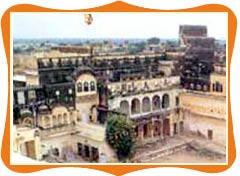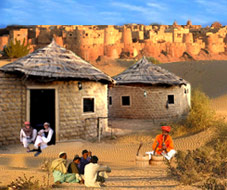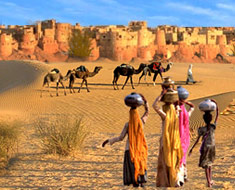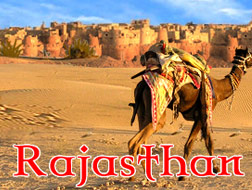 The town of Mandawa was founded and inhabited by Shekhawati Rajput in the 18th century. Mandawa is situated in the Jhunjhunu district of Rajasthan and is popularly known as the Open Air Art Gallery of Rajasthan, due to magnificent murals and frescoes from mythology, legendary tales, and contemporary lifestyle, which adorn the havelis of this town. The town of Mandawa was the place inhibited by the rich and affluent merchant community of Rajasthan, the Marwaris, who got these exquisite havelis built in Mandawa. Apart from the havelis, the market town of Mandawa is renowned for the Mandawa Castle and a number of baolis, or huge water reservoirs.
The town of Mandawa was founded and inhabited by Shekhawati Rajput in the 18th century. Mandawa is situated in the Jhunjhunu district of Rajasthan and is popularly known as the Open Air Art Gallery of Rajasthan, due to magnificent murals and frescoes from mythology, legendary tales, and contemporary lifestyle, which adorn the havelis of this town. The town of Mandawa was the place inhibited by the rich and affluent merchant community of Rajasthan, the Marwaris, who got these exquisite havelis built in Mandawa. Apart from the havelis, the market town of Mandawa is renowned for the Mandawa Castle and a number of baolis, or huge water reservoirs.The historic town of Mandawa served as a trading outpost for the caravans coming from Middle East and China. It was in 1755 that the Rajput ruler, Thakur Nawal Singh got the Mandawa Fort and ramparts around the city constructed for the safety of the trading outpost. The fort towers over the Mandawa city with a painted arched gateway, adorned by the painting of Lord Krishna and his cows. The huge open terraces of the town offer a panoramic view of the whole town below. The entire fort is adorned by beautiful paintings of Lord Krishna, mirror work, and intricate carvings. A large number of antiques and paintings are also on display in the durbar hall of the castle.
The Mandawa Castle has now been converted into a heritage hotel. The beautiful wall paintings that decorate the havelis of Mandawa in Rajasthan have seen the themes changing from time to time. In the earlier days, mythology dominated the themes of the frescoes, displaying local legends, deities, and characters from epics. The onset of the 19th century saw the themes being modified to reflect the British influence on the Indian culture. The traditional subjects were exchanged for cars, trains, gramophones, English men in hunting attires, and portraits of the haveli owners immaculately dressed, etc. Mandawa is not just known for the stunning and intricate works performed on the interiors of the havelis, but also for the beautiful havelis it houses. Built in true Jaipur style of architecture, there are pleasant courtyards, gardens, and balconies with splendid views of the Mandawa Fort which one gets from the Mandawa havelis.
Displaying the skillful craftsmanship of Rajput artisans is the Goenka Double Havelis. The haveli is adorned by life-size portraits of the royal men, traditional Rajasthani women, and religious motifs. The Hanuman Prasad Goenka Haveli has religiously inspired frescoes, like Lord Shiva on Nandi and Lord Indra on his elephant. The Jhunjhunwala Haveli is famous for its intricately carved and painted ceiling and golden leaf painted walls. Carved archways, latticed windows and intricate designs are found in Murmuria Haveli as well. Besides traditional frescoes and murals, the Murmuria Haveli has modern paintings also, like the one depicting Jawaharlal Nehru with the National Flag on a horseback. Mohanlal Saraf Haveli, Chowkhani Haveli, Bhagchandika Haveli, Gulab Rai Ladia Haveli, Lakshmi Narayan Ladia Haveli, and the Newtia Haveli are some other majestic havelis of Mandawa.










